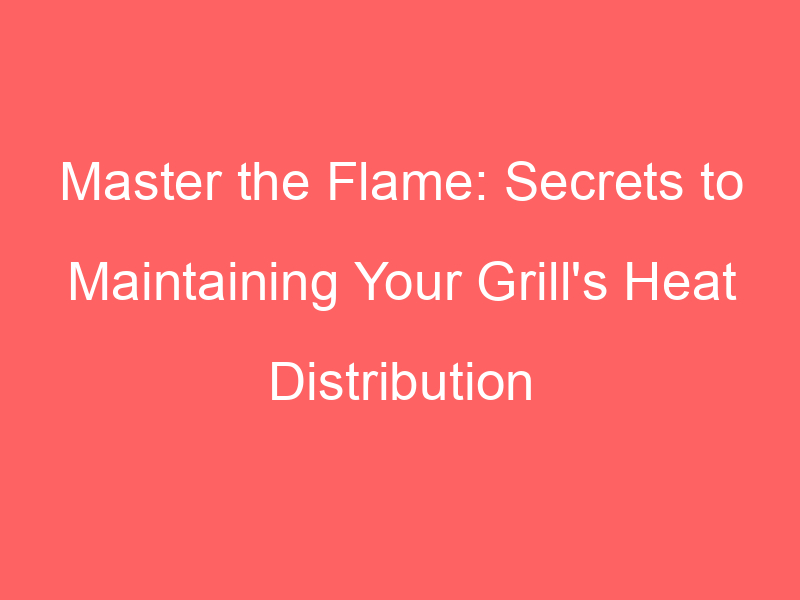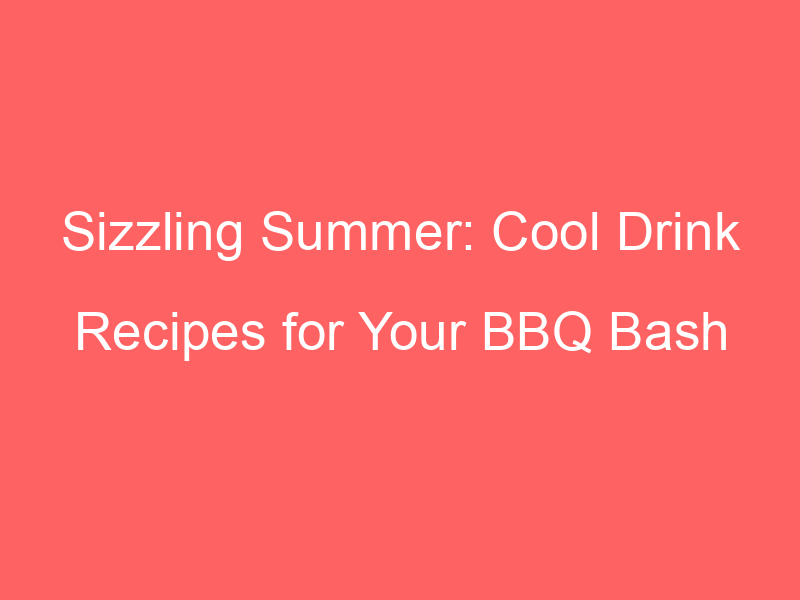Introduction to Grill Heat Management
Hey there, grill masters! Today, we’re going to dive into a super important topic that’s going to take your grilling game to the next level. We’re talking about grill heat management. Trust us, it’s a big deal.
- Understanding the Importance of Grill Heat Control
- Overview of BBQ Grill Heat Maintenance
So, why should you care about grill heat control? Well, it’s simple. The heat of your grill determines how your food cooks. Too hot, and your food might burn on the outside before it’s cooked on the inside. Too cool, and your food could take forever to cook, or not cook evenly. That’s why getting the heat just right is so important.
Now, let’s talk about BBQ grill heat maintenance. This is all about making sure your grill stays at the right temperature for as long as you need it to. It involves things like cleaning your grill regularly, making sure your fuel (like charcoal or gas) is stored properly, and knowing how to adjust your grill’s temperature controls. We’ll get into more detail about all of this later, but for now, just know that good heat maintenance is key to great grilling.
Stick around, because we’ve got a lot more to share about grill heat management. We’ll be covering everything from understanding heat distribution in grills, to grill maintenance for optimal heat distribution, and even some practical tips for grill heat control. Let’s get grilling!
Understanding Heat Distribution in Grills
Hey there, grill enthusiasts! Today, we’re going to dive into the fascinating world of heat distribution in grills. It’s a hot topic (pun intended) that’s crucial to mastering the art of grilling. So, let’s get started!
Factors Affecting Heat Distribution
Ever wondered why your burgers cook unevenly? Or why one side of your grill seems hotter than the other? Well, there are a few key factors that influence how heat is distributed in your grill. Let’s break them down:
- Grill design and material: The design of your grill plays a big role in how heat is spread. For instance, a grill with a dome-shaped lid will distribute heat more evenly than a flat one. The material of your grill also matters. Cast iron grills, for example, retain heat well and provide even cooking.
- Fuel type: The type of fuel you use can also affect heat distribution. Charcoal grills tend to have hot spots, while gas grills often provide more even heat. But remember, it’s not just about the type of fuel, but also how you use it. For instance, arranging your charcoal in a certain way can help distribute heat more evenly.
- Weather conditions: Yep, even the weather can impact your grilling! On a windy day, your grill might lose heat faster, leading to uneven cooking. On the other hand, on a hot and sunny day, your grill might get hotter than you’d expect. So, always consider the weather when you’re planning your grilling session.
Understanding these factors can help you control the heat in your grill better, leading to tastier, more evenly cooked food. So, the next time you fire up your grill, keep these points in mind and see the difference it makes!
Importance of Even Heat Distribution
Hey there, grill masters! Let’s chat about something super important in the grilling world – even heat distribution. You might be wondering, “Why is this so important?” Well, there are two big reasons:
- Ensuring consistent cooking
- Preventing food from burning
Ensuring Consistent Cooking
Imagine you’re grilling up some delicious burgers for your family. You want each one to be cooked just right – not too rare, not too well-done. If your grill doesn’t distribute heat evenly, some burgers might be undercooked while others are overcooked. That’s not what you want, right? Even heat distribution ensures that all your food cooks at the same rate. This way, every bite is as tasty as the last. Wikipedia has some cool info about this!
Preventing Food from Burning
Have you ever had a piece of chicken that was burnt on the outside but raw on the inside? Yuck! This can happen when your grill has hot spots. These are areas that get hotter than the rest of the grill. Food in these spots can burn quickly, while food in cooler spots might not cook through. Even heat distribution prevents this problem, making sure your food is cooked perfectly every time.
So, remember, even heat distribution is key to grilling success. It helps your food cook evenly and prevents it from burning. Next time you fire up the grill, keep this in mind. Happy grilling!
Grill Maintenance for Optimal Heat Distribution
Keeping your grill in tip-top shape is key to ensuring optimal heat distribution. One of the most important aspects of grill maintenance is cleaning. Let’s dive into how you can keep your grill clean and ready for some serious BBQ action!
Cleaning Your Grill
Cleaning your grill isn’t just about making it look good. It’s about making sure your BBQ heats up evenly and cooks your food perfectly. Here’s how:
- Regular cleaning to maintain BBQ heat
- Deep cleaning for long-term grill heat consistency
Regular cleaning is essential to keep your grill performing at its best. After each use, once the grill has cooled down, use a grill brush to scrub off any food particles or grease. This prevents buildup that can interfere with heat distribution. Don’t forget to empty the grease trap too! A clean grill is a happy grill, and a happy grill gives you the best BBQ.
Every few months, it’s a good idea to give your grill a deep clean. This involves removing the grates and burners and cleaning them separately. You might be surprised at how much gunk can accumulate over time! Use a grill cleaner and a scrub brush to really get in there and clean everything. Once everything is clean and dry, reassemble your grill. You’ll notice a difference in how evenly your grill heats up.
Remember, a clean grill is not just about aesthetics. It’s about ensuring your grill heats up evenly, giving you the best possible BBQ experience. So, roll up your sleeves and get cleaning!
Checking and Replacing Grill Parts
Hey there, grill masters! Let’s talk about something super important – checking and replacing grill parts. It’s like giving your grill a health check-up. This not only keeps your grill in top shape but also ensures optimal heat distribution for those perfect BBQs. Let’s dive in!
- Regular inspection of grill parts
- Replacing worn out parts for optimal heat distribution
Just like you’d take your car for regular check-ups, your grill needs the same love. Regular inspection of grill parts can help you spot any potential issues early on. Look out for things like rust, cracks, or any signs of wear and tear. A good rule of thumb is to do a quick check every time you fire up your grill and a more thorough inspection every few months.
Worn out grill parts can mess with your heat distribution, and we don’t want that, do we? If you find any parts that are past their prime during your inspections, it’s time to replace them. This could be anything from grill grates to burners or heat tents. Remember, a well-maintained grill is the secret to evenly cooked, delicious BBQ!
So, there you have it, folks! Regular inspection and timely replacement of grill parts is the key to maintaining optimal heat distribution. Happy grilling!
Practical Tips for Grill Heat Control
Managing the heat on your grill can be tricky, but with a few practical tips, you can become a grill master in no time. One of the most important aspects of heat control is choosing and using the right fuel.
Using the Right Fuel
Not all fuels are created equal when it comes to grilling. The type of fuel you use can have a big impact on the heat distribution and overall grilling experience. Let’s dive into this topic a bit more.
- Choosing the right fuel for your grill
- Understanding how different fuels affect heat distribution
There are several types of fuel you can use for your grill, including charcoal, propane, and natural gas. Charcoal provides a smoky flavor that many grill enthusiasts love, but it can be harder to control the heat. Propane and natural gas grills are easier to manage in terms of heat, but they don’t provide the same flavor as charcoal. You’ll need to decide which type of fuel is right for your grilling needs.
Different fuels distribute heat in different ways. Charcoal, for example, tends to create hot spots and cooler areas on the grill, which can be great for cooking different types of food at the same time. Propane and natural gas, on the other hand, provide more even heat distribution, which can be easier for beginners or for cooking large amounts of food. Understanding how your chosen fuel affects heat distribution can help you grill more effectively.
Remember, the right fuel for your grill will depend on your specific needs and preferences. Don’t be afraid to experiment with different types of fuel to find the one that works best for you!
Adjusting Grill Vents
Adjusting the vents on your grill is like tuning a musical instrument. You’ve got to get it just right to hit the perfect note, or in this case, the perfect temperature. Let’s dive into how you can use vents for grill heat management and the impact of vent adjustment on heat distribution.
- How to use vents for grill heat management
- Case study: Effect of vent adjustment on heat distribution
Grill vents, also known as dampers, are small openings that allow air to flow into the grill. They’re usually found on the top and bottom of the grill. By adjusting these vents, you can control the amount of air that gets in and out, which in turn controls the heat.
Here’s a simple rule of thumb: open vents mean more oxygen, which stokes the fire and increases the heat. Closed vents reduce the oxygen flow, which lowers the heat. So, if you want a high heat for searing steaks, open those vents wide. If you’re aiming for a low and slow cook, keep the vents partially closed.
Let’s look at a practical example. In a study conducted by grill enthusiasts, two identical grills were set up side by side. One grill had its vents fully open, while the other had its vents half-closed. The grills were then heated for 30 minutes.
The grill with the open vents reached a high temperature of 500 degrees Fahrenheit, while the grill with the half-closed vents maintained a steady temperature of 350 degrees. This shows that adjusting the vents can have a significant impact on the grill’s heat distribution.
Remember, every grill is different, and it might take a bit of practice to find the perfect vent settings for your grill. But once you master it, you’ll be able to control your grill’s heat like a pro!
Outdoor Grill Heat Distribution
When it comes to outdoor grilling, understanding how heat is distributed is key. But did you know that the weather can also play a big role in this? Let’s dive in and find out more!
Dealing with Wind and Weather
Weather can be a real game changer when you’re grilling outdoors. It can affect how your grill heats up and how it maintains that heat. But don’t worry, we’ve got some tips to help you out!
- How weather affects grill heat distribution
- Tips for maintaining grill temperature in different weather conditions
- Wind: Try to position your grill in a spot that’s shielded from the wind. You could use a grill cover or even a makeshift windbreak.
- Rain: If it’s raining, you might want to consider grilling under a covered area. Just make sure it’s safe and there’s plenty of ventilation.
- Cold: If it’s really cold outside, you might need to use more fuel to get your grill to the right temperature. And remember, patience is key!
Wind, rain, and even the temperature outside can affect your grill’s heat distribution. Wind can blow heat away from your grill, making it harder for it to reach the right temperature. Rain can cool down your grill, and if it’s really cold outside, your grill might struggle to heat up at all. It’s like trying to heat up a popsicle in a snowstorm!
So, how do you deal with these weather challenges? Here are some tips:
Remember, the key to great grilling is understanding how heat works and how to control it. And now that you know how weather can affect your grill’s heat distribution, you’re one step closer to becoming a grill master!
Positioning Your Grill
When it comes to grilling, where you place your grill matters a lot. It’s not just about convenience, it’s also about how well your grill performs. Let’s explore this further.
- Choosing the right location for your grill
- Keep it away from flammable materials: This includes wooden decks, trees, and your house. A good rule of thumb is to keep your grill at least 10 feet away from any structure.
- Consider the wind: Wind can affect your grill’s performance. If possible, position your grill so it’s shielded from the wind.
- Think about convenience: Your grill should be close enough to your kitchen to make food prep easy, but not so close that smoke enters your home.
- How grill positioning affects heat distribution
- If your grill is in a windy spot, the wind can blow the heat away, making it harder for your grill to maintain a steady temperature. This can lead to uneven cooking.
- If your grill is too close to a wall or other structure, it can create a “heat trap” that can cause your grill to get too hot, which can burn your food.
- On the other hand, if your grill is in a spot that gets a lot of sun, it can help your grill heat up faster and stay hot longer. Just be sure to watch out for overheating!
Choosing the right spot for your grill is like finding the perfect home. It needs to be safe, comfortable, and practical. Here are some tips:
Did you know that where you place your grill can affect how it heats up? It’s true! Here’s how:
So, the next time you fire up your grill, take a moment to think about where it’s positioned. It could make a big difference in your grilling experience!
Conclusion: Mastering Grill Heat Distribution
Well, folks, we’ve reached the end of our grilling journey. We’ve learned a lot about how to manage and distribute heat on our grills. Now, let’s wrap it all up with some key takeaways and final thoughts.
- Key takeaways for maintaining BBQ heat
- Preheat your grill: This helps to kill any bacteria and gives you a clean surface to cook on.
- Control your heat: Use the grill’s vents to control the heat. Open vents mean more oxygen, which means more heat. Closed vents mean less oxygen, which means less heat.
- Use a thermometer: This is the best way to know the exact temperature inside your grill. Don’t rely on guesswork!
- Clean your grill: Regular cleaning helps to maintain heat distribution and prolongs the life of your grill.
- Final thoughts on grill heat distribution tips
- Patience is key: Don’t rush your cooking. Good things come to those who wait!
- Practice makes perfect: The more you grill, the better you’ll get at controlling and distributing heat.
- Don’t be afraid to experiment: Try different methods of heat distribution to see what works best for you.
- Enjoy the process: Grilling is not just about the end result. It’s about the joy of cooking outdoors, the smell of the smoke, and the satisfaction of creating something delicious with your own hands.
Remember, maintaining the right heat in your BBQ is crucial for cooking your food evenly and deliciously. Here are the main points to keep in mind:
Mastering grill heat distribution might seem like a daunting task at first, but with practice, it becomes second nature. Here are some final thoughts:
So there you have it, the ins and outs of mastering grill heat distribution. Now, it’s time for you to fire up that grill and start cooking. Happy grilling!






